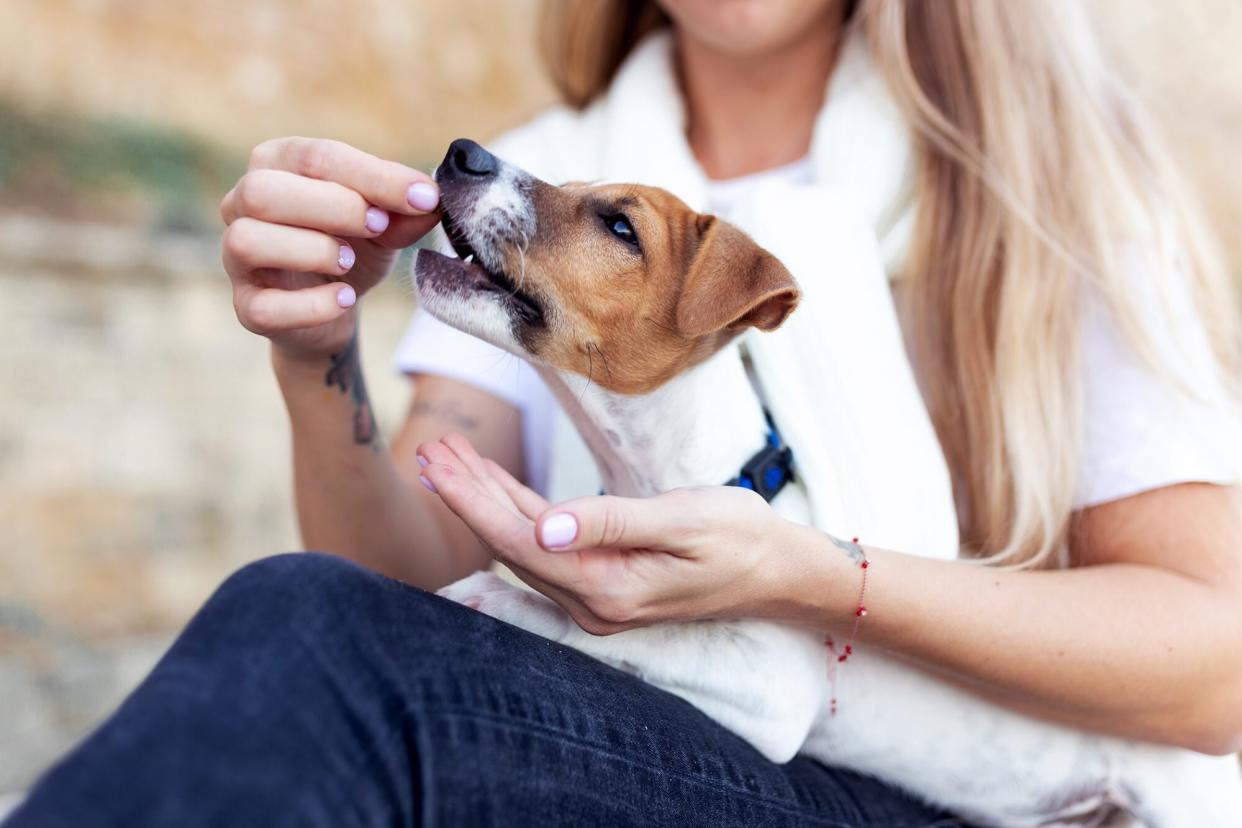Why Does My Dog Want to Be Hand Fed? Here's What Vets Think Might Be Happening

Алина Битта / Adobe Stock
To develop a strong bond with our dogs, we start by building trust. The way we call their names, give them pats, and offer treats all have an important role in establishing a loving, secure connection. For example, a piece of kibble on the tip of your fingers might be exactly the right way to coax your pooch to eat more slowly or to reward them.
However, sometimes pups refuse to eat from their bowls and only accept food from their humans. "Why does my dog want to be hand fed?" is a common question for many pet parents stymied by this behavior, especially if it comes on suddenly. We asked veterinarians for reasons why this might happen.
Why Dogs Want to Be Hand Fed
Separation anxiety is one possible clue as to why your dog wants to be hand fed, and that condition has many contributing factors. If your pup is a rescue, for instance, and certain triggers upset them, they might want to be hand fed as a form of comfort. Or your pooch doesn't like being home alone, and seeks more of your direct attention before you leave for work or when you return.
"We have a few dogs that board with us that will only eat if they're hand fed," says Sara Redding Ochoa, DVM, of Whitehouse Veterinary Hospital. "They may be unsure of their surroundings and not happy being left, and this is the only way we can get them to eat when they stay with us."
Here are other potential reasons your pup might prefer nibbles from your palm:
Sickness: Sometimes when they're under the weather, nurturing them with teaspoons of a bland diet assures they get some sustenance.
Multiple dogs: Many hungry pups at feeding time might cause chaos, resulting in some not getting enough to eat from the dog bowls.
Human conditioning: Your dog might be eating out of hand because of conditioned behavior created when they were sick or acting picky, during a switch in dog food, or they came from another situation—such as a shelter, foster family, previous owner, or breeder—where hand feeding was the norm.
Trauma: A negative event happened near the food bowl and now they associate eating out of a bowl with it. Likewise, if something scared them during feeding, like another dog or a loud noise, this fear may stick with them.
Too distracted: Dogs who are vigilant about monitoring their surroundings might be too preoccupied to take time away to eat from their bowl.
Is Hand Feeding a Dog Bad?
Not necessarily. Positive reinforcement trainers frequently hand feed treats not only to teach dogs essential skills and new tricks, but also to help with impulse control, reduce resource guarding (which is when a dog becomes reactive about sharing their personal space), and build trust with fearful or shy dogs.
But hand feeding a dog all the time might simply not be practical. So anytime your dog stops eating voluntarily from their bowl, it's important to schedule a veterinary exam to rule out any medical problems.
RELATED: 14 Tips for First-Time Dog Owners
Training Your Dog to Eat From a Bowl
Once your pup receives a clean bill of health, work with your vet, a trainer, or a certified behavior expert to determine why the habit started and find ways to get your pup back to the bowl.
"I had a dog that loved to be hand-fed," says Michelle Burch, DVM, from SafeHounds Pet Insurance. She broke the habit by letting her pup eat pieces out of her hand first, then holding out the bowl so her pet ate a few more pieces from there. You can switch back and forth like this over time to gradually recondition your dog.
Here are some other popular methods:
If it's an issue with other canines, "feeding these dogs in separate rooms allows them time to eat," Ochoa says. You may even have to supervise mealtime and stay with your hand-feeder to make sure they finish.
If there's a problem with the location of the bowl, move it someplace that seems more safe and secure to them. "An excellent place to feed your dog is in their crate with the door closed and possibly a blanket over it," Burch says. This new location becomes their safe eating zone that provides enough security so they can calmly eat at their own pace.
Try adjusting their feeding time slightly to a more relaxed hour, instead of when everyone is rushing around to leave the house or busy with dinner prep. Choose a 30-minute stretch when the family is home and settled.
Enrich mealtimes. "I recommend making mealtime an enrichment period for your pet to help prevent boredom," Burch adds. Use a slow feeder, puzzle feeder, or a snuffle mat—a brain game that makes it challenging and fun for your pup to pick out the kibble. All these products encourage your pup to use their sense of smell and provide mental stimulation.
Add interest and variety to mealtimes by rotating dog food flavors. Stock different protein choices, such as beef, chicken, and salmon, and change them up every other day or so. Or try something like Enjoy-A-Bowl, a two-tiered bowl that helps entice picky eaters.
Make sure you're not overfeeding your dog. Your pup may need to be hungry in order to learn how to eat out of his bowl again.
RELATED: How Much Food Does Your Dog Really Need?
By practicing tips like these, soon your furry friend makes the connection that meals come from their special bowl, and hand-fed treats mean quality time with you!

